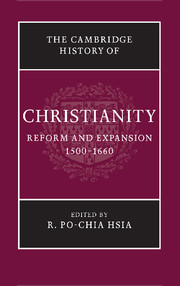Book contents
- Frontmatter
- Part I Luther and the Holy Roman Empire
- Part II The Second Reformation
- Part III Catholic Renewal
- Part IV Resolving Confessional Conflicts
- Part V Religion, Society, and Culture
- Part VI Christianity and Other Faiths
- 26 Christianity and Judaism
- 27 The naturalization of Andean Christianities
- 28 Between Islam and Orthodoxy: Protestants and Catholics in south-eastern Europe
- 29 Christianity shaped by the Chinese
- 30 Reception of Hinduism and Buddhism
- Bibliography
- Index
- References
29 - Christianity shaped by the Chinese
from Part VI - Christianity and Other Faiths
Published online by Cambridge University Press: 28 March 2008
- Frontmatter
- Part I Luther and the Holy Roman Empire
- Part II The Second Reformation
- Part III Catholic Renewal
- Part IV Resolving Confessional Conflicts
- Part V Religion, Society, and Culture
- Part VI Christianity and Other Faiths
- 26 Christianity and Judaism
- 27 The naturalization of Andean Christianities
- 28 Between Islam and Orthodoxy: Protestants and Catholics in south-eastern Europe
- 29 Christianity shaped by the Chinese
- 30 Reception of Hinduism and Buddhism
- Bibliography
- Index
- References
Summary
Introduction
There are different ways of writing the history of the expansion of Christianity and its evangelization of the non-Christian world. The common approach is to write it from the perspective of the European missionary, whereby the process of Christianization is primarily perceived as the result of the missionary’s action. Another approach is to take the receiving community as the starting point of discussion; thereby emphasizing this community’s role as an active participant in the conversion process. This chapter will adopt the latter approach. By focusing on the Chinese, both Christian and non-Christian, it will show how these actors, in interaction with the respective missionaries, shaped the form of Christianity in seventeenth-century China.
The account of this historic interaction begins with the year 1583, the first time local Chinese authorities granted missionaries permanent residence in mainland China. During the preceding thirty years, i.e., since 1552, the year in which Francisco Xavier (1506–52) died on an island off the Chinese coast, some fifty missionaries had been trying in vain to settle in China. The closing date of this account is 1666. In that year, Chinese authorities banished all but four missionaries to confinement in Canton. During a period of approximately five years, all churches in the provinces were closed and Christianity forbidden. Although 1666 therefore represents a closing date that fits elegantly within the time-frame set by this volume of the Cambridge History of Christianity, the events that took place during this time should not necessarily be considered the most significant in the process of evangelization in China. From the point of view of Chinese secular history, 1644 is a more important date.
- Type
- Chapter
- Information
- The Cambridge History of Christianity , pp. 558 - 576Publisher: Cambridge University PressPrint publication year: 2007
References
- 2
- Cited by



